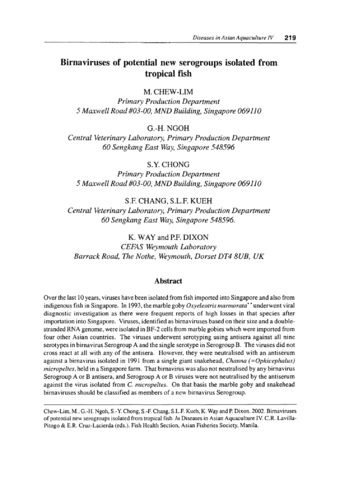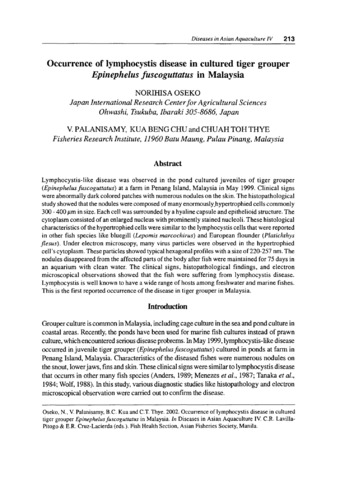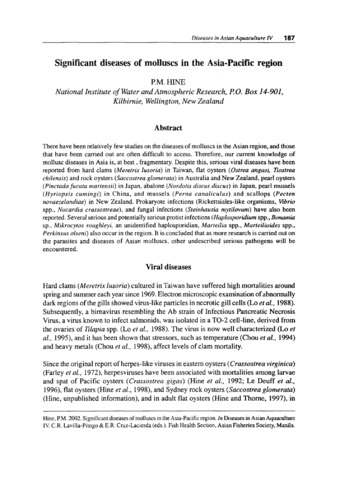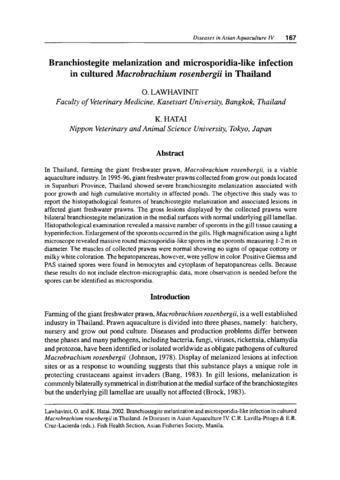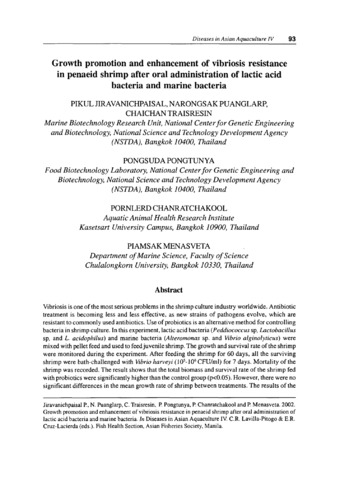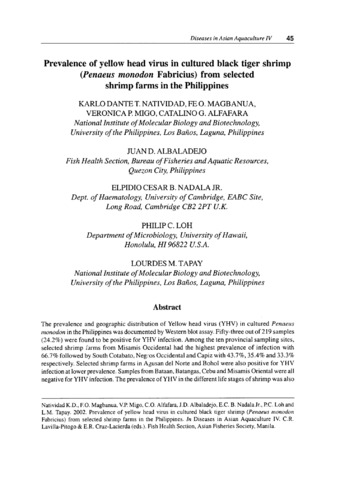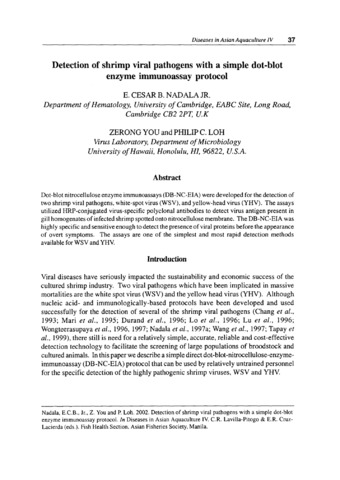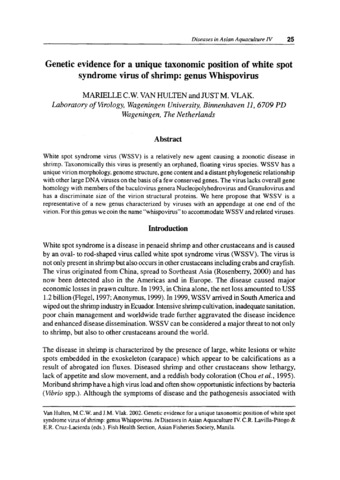SEAFDEC/AQD-Asian Fisheries Society: Recent submissions
Now showing items 21-40 of 43
-
Detection and identification of aquatic Mycobacterium species in fish, fish farm workers and the environment
(Fish Health Section, Asian Fisheries Society, 2002)Mycobacteriosis, caused by Mycobacterium spp, is a common disease in snakehead (Channa striata) and Siamese fighting fish (Betta splendens). In Thailand, snakehead is an economically important food species, while Siamese ... -
Pathogenic Vibrio isolates from cultured seabass (Lates calcarifer), groupers (Epinephelus spp.) and red snappers (Lutjanus spp.)
(Fish Health Section, Asian Fisheries Society, 2002)Heavy mortality of cultured seabass (Lates calcarifer), groupers (Epinephelus spp.) and snappers (Lutjanus spp.) due to bacterial infection is a common problem in Malaysia. All the three species exhibited a wide range of ... -
Birnaviruses of potential new serogroups isolated from tropical fish
(Fish Health Section, Asian Fisheries Society, 2002)Over the last 10 years, viruses have been isolated from fish imported into Singapore and also from indigenous fish in Singapore. In 1993, the marble goby Oxyeleotris marmorata** underwent viral diagnostic investigation as ... -
Occurrence of lymphocystis disease in cultured tiger grouper Epinephelus fuscoguttatus in Malaysia
(Fish Health Section, Asian Fisheries Society, 2002)Lymphocystis-like disease was observed in the pond cultured juveniles of tiger grouper (Epinephelus fuscoguttatus) at a farm in Penang Island, Malaysia in May 1999. Clinical signs were abnormally dark colored patches with ... -
Major viral and bacterial diseases of cultured seabass and groupers in Southeast Asia
(Fish Health Section, Asian Fisheries Society, 2002)Floating net-cage culture of fish was established in the early 1970s in Southeast Asia and has become very popular since. Although several species of marine and diadromous fishes have been successfully cultured, only a few ... -
Diseases of maricultured gastropods and bivalves in Japan
(Fish Health Section, Asian Fisheries Society, 2002)Recently, some serious disease problems have occurred in cultured species of gastropods and bivalves in Japan. Among the current problems, amyotrophia of abalones (Nordotis species) and epizootic mortality of pearl oysters ... -
Significant diseases of molluscs in the Asia-Pacific region
(Fish Health Section, Asian Fisheries Society, 2002)There have been relatively few studies on the diseases of molluscs in the Asian region, and those that have been carried out are often difficult to access. Therefore, our current knowledge of mollusc diseases in Asia is, ... -
Viral infections in Australian freshwater crayfish
(Fish Health Section, Asian Fisheries Society, 2002)Viral diseases of freshwater crayfish are poorly understood. To date, much of the research in this field has been conducted in Australia and/or on Australian freshwater crayfish species. Cherax tenuimanus, Cherax destructor ... -
Branchiostegite melanization and microsporidia-like infection in cultured Macrobrachium rosenbergii in Thailand
(Fish Health Section, Asian Fisheries Society, 2002)In Thailand, farming the giant freshwater prawn, Macrobrachium rosenbergii, is a viable aquaculture industry. In 1995-96, giant freshwater prawns collected from grow out ponds located in Supanburi Province, Thailand showed ... -
Histopathology of a novel melanized lesion in the branchiostegite of cultured penaeid shrimps
(Fish Health Section, Asian Fisheries Society, 2002)During routine investigations for white spot syndrome virus (WSSV) in shrimp farms of Kundapur in the West Coast of India, a novel melanized proliferative lesion was observed in the branchiostegite of Penaeus monodon and ... -
Emerging shrimp diseases and innovations to prevent their spread
(Fish Health Section, Asian Fisheries Society, 2002)The number of diseases affecting cultivated penaeid shrimp has increased steadily with expansion and intensification of large-scale commercial cultivation. In the 1990s the most serious losses have occurred from the emergence ... -
Alkalinity control in ozonated shrimp pond water
(Fish Health Section, Asian Fisheries Society, 2002)The use of ozone for aquaculture has been shown to be effective, not only for disinfection of pathogenic bacteria and viruses, but also for removal of toxic ammonia, nitrite and hydrogen sulfide. However, ozonation of ... -
Effects of Artemia enriched with L-ascorbyl dipotassium-2-sulfate dihydrate on stress tolerance and disease resistance of Penaeus monodon postlarvae
(Fish Health Section, Asian Fisheries Society, 2002)Penaeus monodon postlarvae (stage 10) were reared with Artemia nauplii enriched with 50,100 and 150 mg/l (ppm) of L-ascorbyl-dipotassium-2- sulfate dihydrate for 5 days. Postlarvae in the control group were given non-enriched ... -
Growth promotion and enhancement of vibriosis resistance in penaeid shrimp after oral administration of lactic acid bacteria and marine bacteria
(Fish Health Section, Asian Fisheries Society, 2002)Vibriosis is one of the most serious problems in the shrimp culture industry worldwide. Antibiotic treatment is becoming less and less effective, as new strains of pathogens evolve, which are resistant to commonly used ... -
Evaluation of the susceptibility of the shrimp Litopenaeus vannamei to vibriosis when exposed to agriculture pesticides
(Fish Health Section, Asian Fisheries Society, 2002)Due to increasing stringency of environmental regulations, agricultural production systems have switched from persistent pesticides to products which degrade more rapidly. In spite of that, new pesticide products can affect ... -
Identification and characterization of Vibrio bacteria isolated from fish and shellfish in Vietnam
(Fish Health Section, Asian Fisheries Society, 2002)A taxonomic relationship of thirty one Vietnamese bacterial isolates from different fish and shellfish together with twenty two reference strains was investigated by Euclidean distance with unweighted average linkage ... -
Quorum sensing and its potential application to vibriosis
(Fish Health Section, Asian Fisheries Society, 2002)Quorum sensing is a gene regulatory mechanism by which certain pathogenic and symbiotic bacteria respond to population density and host association. By mediating the ability of bacteria such as Vibrio harveyi to infect ... -
Prevalence of yellow head virus in cultured black tiger shrimp (Penaeus monodon Fabricius) from selected shrimp farms in the Philippines
(Fish Health Section, Asian Fisheries Society, 2002)The prevalence and geographic distribution of Yellow head virus (YHV) in cultured Penaeus monodon in the Philippines was documented by Western blot assay. Fifty-three out of 219 samples (24.2%) were found to be positive ... -
Detection of shrimp viral pathogens with a simple dot-blot enzyme immunoassay protocol
(Fish Health Section, Asian Fisheries Society, 2002)Dot-blot nitrocellulose enzyme immunoassays (DB-NC-EIA) were developed for the detection of two shrimp viral pathogens, white-spot virus (WSV), and yellow-head virus (YHV). The assays utilized HRP-conjugated virus-specific ... -
Genetic evidence for a unique taxonomic position of white spot syndrome virus of shrimp: Genus Whispovirus
(Fish Health Section, Asian Fisheries Society, 2002)White spot syndrome virus (WSSV) is a relatively new agent causing a zoonotic disease in shrimp. Taxonomically this virus is presently an orphaned, floating virus species. WSSV has a unique virion morphology, genome ...



